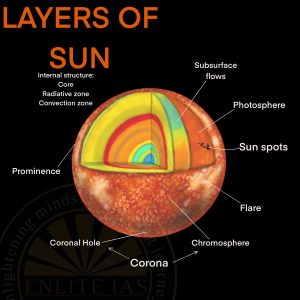Basics of Sun
- Age – 4.6 billion years
- Diameter – 1.39 million km
- Temperature – 6000 °C on the surface
- The surface gravity of the Sun is 274 m/s2
- Period of rotation – 25 days 9 hrs.
- Rotation – counterclockwise
- Composition – 98% of the sun is hydrogen & helium.
- Most of the solar system’s mass is in the Sun (~99.8%), with most of the remaining mass contained in Jupiter and Saturn.
Layers of Sun
- Photosphere
- The photosphere is an extremely uneven bright outer layer of the Sun that emits most of the radiation.
- The temperature on the outer side of the photosphere is 6000°C.
- Chromosphere
- Above the photosphere is the chromosphere.
- It is a thin layer of burning gases.
- It is comparatively cooler — 4320°C
- Corona
- A corona is a distinctive atmosphere of plasma that surrounds the Sun and other celestial bodies.
- The Sun’s corona extends millions of kilometres into space and is most easily seen during a total solar eclipse.
- Solar wind is an outflow of gas from the corona.

Associated Terms
- Sunspot
- Sunspots are temporary phenomena on the photosphere of the Sun that appear visibly as dark spots compared to surrounding regions.
- They appear as dark areas because they are about 500-1500°C cooler than the surrounding chromosphere.
- They correspond to concentrations of the magnetic field that inhibit convection & result in reduced surface temperature compared to the surrounding photosphere.
- Sunspot activity cycles about every eleven years.
- The point of highest sunspot activity during this cycle is known as Solar Maximum, and the point of the lowest activity is Solar Minimum.
- The individual sunspot has a lifetime ranging from a few days to a few months.
- Each spot has a black centre or umbra, and a lighter region or penumbra, surrounding it.
- Sun Wind
- The solar wind is made of plasma (ionised atoms), a stream of energised, charged particles, primarily electrons and protons, flowing outward from the Sun at speeds as high as 900 km/s and at a temperature of 1 million°C.
- Solar Flares
- Solar flares are magnetic storms which appear to be very bright spots with a gaseous surface eruption.
- As solar flares are pushed through the corona, they heat its gas to anywhere from 10 to 20 million°C.
- Solar Prominence
- An arc of gas that erupts from the surface of the Sun is called solar prominence.
- Prominences can loop hundreds of thousands of miles into space.
- They are held above the Sun’s surface by strong magnetic fields and can last for many months.
